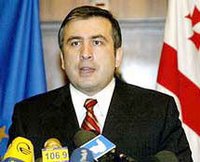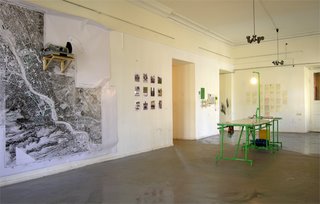Freya’s notes of conversations with people who took part in the ERforS project: ‘Georgia He We Come’ in March 2006.- The stay in Georgia especially taught me a lot about myself. You realise that things that are normal to you do originate somewhere specific.
- Dutch people think in steps and are used to planning. Georgians are interested in that but are constantly confronted with changes in society and then planning seems in vain. Architects would really like to work the way people work in the Netherlands. They miss the planning and targeted way of working. I think a lack of knowledge amongst the teachers contributes to this problem.
- There is a will but not yet a way and there is a lot of energy in people but they are sceptic and they are often laconic about their own actions and live from day to day.
- The typical Dutch design, which is completely integrated in society doesn’t work in Georgia. In Georgia you notice a negative reaction to design that reminds them of Russian design from during the communist era. ‘Western design is en vogue’
- Men dance together like Moroccan men.
- Georgians have black humour.
- Sometimes apartment buildings are finished only by casco and the inhabitants give their personal input to the rest of the house including the front and rear façade.
- It could be that you are sharper when you are there for a short time because then you don’t have the time to get annoyed by things.
- I know people are disillusioned asking themselves: what can we do or change and what will be the effect? They are used to not having anything and they are on the edge of the world and it is hard to get out because of visa regulations and money issues.
- I found it very valuable that we had access to the art community and the right people and they to us.
- On a social level it was valuable to hang out around the table and then, when the power goes out, you improvise. We played guitar, people sang, it was romantic.
You get to know people and meet them on the street. Projects grew out of conversations.
- What was interesting about being in this different world was to see what art can mean in this situation and you see that it can take a whole different shape.
What I saw that there was less institutional pressure determining the topics people work with, like you sometimes feel in the Netherlands. It is off the ‘cultural map’ that is being made by cultures who have more means to exchange. Specific stuff I saw was artists making connections between performance and art and using their cultural identity in their work in a very conscious manner.
Teike Asselbergs from Orgacom
For an artist that mostly realises work based on peoples narratives about their organisation or group it is difficult enough to get into another culture an realise a project within the time-frame of less than 3 weeks. It was however a new experience for me to additionally find myself in a country and city where both the language and letters were totally unfamiliar to me and where English is spoken by only by a few.
The first few days (I arrived a couple of days late into the project) I spend catching up, seeing the touristic sights the others had photographed the days before. I wondered what to do. My first idea was to produce some new types of souvenirs, but later I realised this idea came only to my mind because I had been involved in a workshop about this topic the week before, in Istanbul. The best of this and of any other recidency is to meet interresting new people. In this regard this recidency was extremely rewarding. The real luxery of this recidency is that there are people to translate both language and culture-wise, what is happening and what is said by people living in Tbilisi. Some recidencies are luxurious in other ways, but the visit can be made just as well by anybody on their own account. I think it is safe to say there is no way, except maybe if you master Russian, that one could find those interresting people relevant to specific ways of working - let alone speak to them - in Georgia, without the help of GEO-AIR.
Another luxery of the recidency is the Georgian Food! I now know where to word 'georgious' stems from. It was good to share dinners with the other participants of the recidency and the Tbilisi people that were part of our various projects and make sense of all new impressions together. It was usefull to share thoughts on projects because they progressed faster and in relation to eachother.
Because I live partly in Turkey I want to get to know artists in the bordering countries. I found out I have lovely neighbours. Nadia and Sopo also visited me back in Istanbul. Who can say that of their host-residency? Spin-off of this visit is that the three of us will participate in the biennual Sinopale in Turkey during the summer of 2006.
Although initially the drive for me to commit to the Enough-room-for-space project for me was the possibility to start networking in Georgia, as the days progressed I wanted to join the frantic production fever more and more and produce some art work in the space. The good thing about the Enough-room-for-space project is that it is open enough not to stear things to much in one direction, but energetic enough to made me want to produce something.
Since Orgacom artist-initiative has plenty of experience in combining content with organisation and the momentum in Tbilisi is now towards setting up new art initiatives (something which is also happening in Istanbul) this was something I felt strongly related to. Somehow after speaking to Elias I decided that it could be interresting to organise my meetings with Tbilisi artists around the topic of setting up artist initiatives. Therefore I allocated my art budget to a prize for the best artist-initiative concept of 2006. The lecture to the art students and artists - which was part of the Enough-room-for-space project - was very helpfull to introduce the prize-idea to my target audience.
The winner(s) use the money to realise their idea and my use of being in Tbilisi would be that all artists that intended to enter the competition could plunder my mind for international contacts and examples. This resulted in discussions about: what is the difference between an art project and an initiative? and how open or how specific should the identity/focus of an initiative be formulated?
For me the creative moment and the notion of succes is linked to collaboratively find a novel 'fit' between artistic content and models of organisation. This happened in several cases in discussions with participating artists. I will stay available to them long after my recidency to co-develop the initiatives. My intention is to visit Tbilisi again or host some Georgian artists in an art initiative space in Istanbul in which I am involved.






